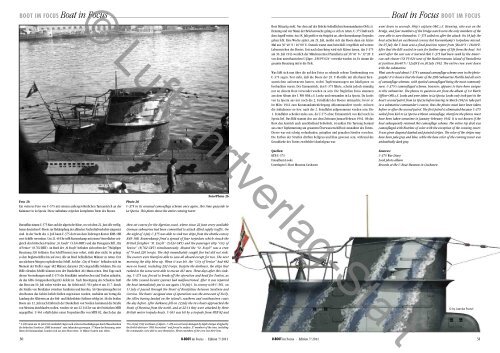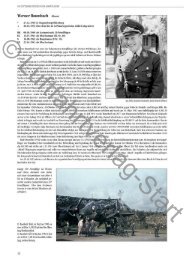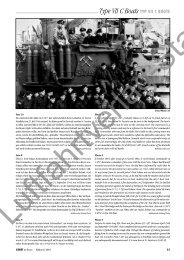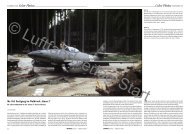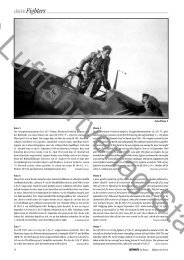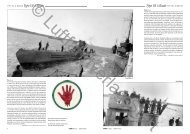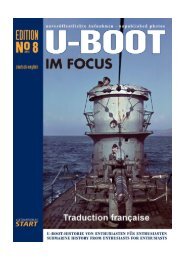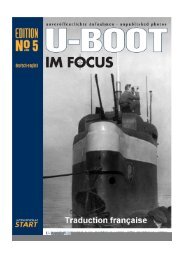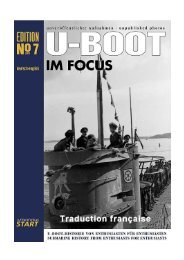Boat in Focus BOOT IM FOCUS
Boat in Focus BOOT IM FOCUS
Boat in Focus BOOT IM FOCUS
Erfolgreiche ePaper selbst erstellen
Machen Sie aus Ihren PDF Publikationen ein blätterbares Flipbook mit unserer einzigartigen Google optimierten e-Paper Software.
<strong>BOOT</strong> <strong>IM</strong> <strong>FOCUS</strong> <strong>Boat</strong> <strong>in</strong> <strong>Focus</strong> <strong>Boat</strong> <strong>in</strong> <strong>Focus</strong> <strong>BOOT</strong> <strong>IM</strong> <strong>FOCUS</strong><br />
Foto 26<br />
E<strong>in</strong> weiteres Foto von U-375 mit se<strong>in</strong>em außergewöhnlichen Tarnanstrich an der<br />
Kaimauer <strong>in</strong> La Spezia. Diese Aufnahme zeigt den kompletten Turm des Bootes.<br />
Daraufh<strong>in</strong> nimmt U-375 Kurs auf die algerische Küste, wo seit dem 22. Juni alle verfügbaren<br />
deutschen U-Boote zur Bekämpfung des alliierten Nachschubverkehrs e<strong>in</strong>gesetzt<br />
s<strong>in</strong>d. In der Nacht des 4. Juli kann U-375 dort aus dem Zubr<strong>in</strong>ger-Konvoi KMS-18B<br />
zwei Schiffe versenken. Um 21.40 Uhr trifft Koenenkamp mit e<strong>in</strong>em Viererfächer zeitgleich<br />
den britischen Frachter „St. Essylt“ (5.634 BRT) und das Passagierschiff „City<br />
of Venice“ (8.762 BRT). An Bord der „St Essylt“ bef<strong>in</strong>den sich neben der 79köpfigen<br />
Besatzung 320 Soldaten. Das Schiff brennt zwar sofort, s<strong>in</strong>kt aber nicht. So gel<strong>in</strong>gt<br />
es den Begleitschiffen bis auf zwei, alle an Bord bef<strong>in</strong>dlichen Männer zu retten. Erst<br />
am nächsten Morgen explodiert das Schiff. Auf der „City of Venice“ bef<strong>in</strong>den sich im<br />
Moment der Treffer sogar 482 Männer, darunter 292 e<strong>in</strong>geschiffte Soldaten. Die zur<br />
Hilfe eilenden Schiffe können trotz der Dunkelheit 461 Mann retten. Drei Tage nach<br />
diesen Versenkungen muß U-375 die Fe<strong>in</strong>dfahrt unterbrechen und Toulon anlaufen,<br />
da das GHG (Gruppenhorchgerät) defekt ist. Nach Beseitigung des Schadens läuft<br />
das Boot am 10. Juli sofort wieder aus. Im Geleit mit U-561 geht es am 11.7. durch<br />
die Straße von Bonifatius zwischen Sard<strong>in</strong>ien und Korsika. Als Operationsgebiet ist<br />
den Booten das Gebiet östlich Sizilien zugewiesen worden, nachdem am Vortag die<br />
Landung der Alliierten an der Süd- und Südostküste Siziliens erfolgt ist. Als die beiden<br />
Boote am 12. Juli nach E<strong>in</strong>bruch der Dunkelheit von Norden kommend die Straße<br />
von Mess<strong>in</strong>a durchlaufen wollen, werden sie um 22.14 Uhr von drei britischen MTB<br />
angegriffen. U-561 erhält dabei e<strong>in</strong>en Torpedotreffer von MTB 82, durch den das<br />
* U-409 wurde am 12. Juli 1943 nordöstlich Algier nach schweren Beschädigungen durch Wasserbomben<br />
des britischen Zerstörers „HMS Inconstant“ zum Auftauchen gezwungen. 37 Mann der Besatzung, unter<br />
ihnen der Kommandant, konnten sich aus dem Boot retten. 11 Männer kamen ums Leben.<br />
Foto/Photo 26<br />
Photo 26<br />
U-375 <strong>in</strong> its unusual camouflage scheme once aga<strong>in</strong>, this time quayside <strong>in</strong><br />
La Spezia. This photo shows the entire conn<strong>in</strong>g tower.<br />
then set course for the Algerian coast, where s<strong>in</strong>ce 22 June every available<br />
German submar<strong>in</strong>e had been committed to attack Allied supply traffic. On<br />
the night of 4 July U-375 was able to s<strong>in</strong>k two ships from the shuttle convoy<br />
KMS-18B. Koenenkamp fired a spread of four torpedoes which struck the<br />
British freighter “St. Essylt” (5,634 GRT) and the passenger ship “City of<br />
Venice” (8,762 GRT) simultaneously. Aboard the “St. Essylt” was a crew<br />
of 79 and 320 troops. The ship immediately caught fire but did not s<strong>in</strong>k.<br />
The escorts were therefore able to save all aboard except for two. The next<br />
morn<strong>in</strong>g the ship blew up. When it was hit, the “City of Venice” had 482<br />
men on board, <strong>in</strong>clud<strong>in</strong>g 292 troops. Despite the darkness, the ships that<br />
rushed to the scene were able to rescue 461 men. Three days after this s<strong>in</strong>k<strong>in</strong>g,<br />
U-375 was forced to break off the operation and head for Toulon, as<br />
the GHG (sound locater system) had malfunctioned. After it was repaired<br />
the boat immediately put to sea aga<strong>in</strong> (10 July). In convoy with U-561, on<br />
11 July it passed through the Strait of Bonifatius between Sard<strong>in</strong>ia and<br />
Corsica. The boats’ assigned area of operations was the area east of Sicily,<br />
the Allies hav<strong>in</strong>g landed on the island’s southern and southeastern coats<br />
the day before. After darkness fell on 12 July the two boats approached the<br />
Strait of Mess<strong>in</strong>a from the north, and at 22:14 they were attacked by three<br />
British motor torpedo boats. U-561 was hit by a torpedo from MTB 82 and<br />
*On 12 July 1943 northeast of Algiers, U-409 was seriously damaged by depth charges dropped by<br />
the British destroyer “HMS Inconstant” and forced to surface. 37 members of the crew, <strong>in</strong>clud<strong>in</strong>g<br />
the commander, were able to save themselves. Eleven members of the crew lost their lives.<br />
Boot blitzartig s<strong>in</strong>kt. Nur dem auf der Brücke bef<strong>in</strong>dlichen Kommandanten Oblt.z.S.<br />
Henn<strong>in</strong>g und vier Mann der Brückenwache gel<strong>in</strong>g es sich zu retten. U-375 läuft nach<br />
dem Angriff weiter. Am 18. Juli greift es e<strong>in</strong> Ostgeleit an, aber Koenenkamps Torpedos<br />
gehen fehl. E<strong>in</strong>e Woche später, am 25. Juli, meldet sich das Boote dann e<strong>in</strong> letztes<br />
Mal aus 36°40’ N / 16°00’ E. Danach wartet man beim BdU vergeblich auf weitere<br />
Lebenszeichen des Bootes. Erst nach dem Krieg wird sich klären lassen, das U-375<br />
am 30. Juli 1943 westlich der Mittelmeer<strong>in</strong>sel Pantelleria auf 36°40’ N / 12°28’ E<br />
von dem amerikanischen U-Jäger „USS PV-624“ versenkt worden ist. Es nimmt die<br />
gesamte Besatzung mit <strong>in</strong> die Tiefe.<br />
Was läßt sich nun über die auf den Fotos zu sehende seltene Tarnbemalung von<br />
U-375 sagen. Fest steht, daß die Boote der 29. U-Flottille mit allerhand Tarnanstrichen<br />
aufzuwarten hatten, wobei Tupfentarnungen am häufigsten zu<br />
beobachten waren. Der Tarnanstrich, den U-375 führte, sche<strong>in</strong>t jedoch e<strong>in</strong>malig<br />
nur an diesem Boot verwendet worden zu se<strong>in</strong>. Die fraglichen Fotos stammen<br />
aus dem Album des I. WO Oblt.z.S. Looks und entstanden <strong>in</strong> La Spezia. Da Looks<br />
von La Spezia aus nur noch die 2. Fe<strong>in</strong>dfahrt des Bootes mitmachte, bevor er<br />
im März 1942 zum Kommandantenlehrgang abkommandiert wurde, müssen<br />
die Aufnahmen vor bzw. nach der 2. Fe<strong>in</strong>dfahrt aufgenommen worden se<strong>in</strong>. Die<br />
1. Fe<strong>in</strong>dfahrt scheidet <strong>in</strong>des aus, da U-375 ohne Tarnanstrich von Kiel nach La<br />
Spezia lief. Das Bild stammt also aus dem Zeitraum Januar/Februar 1942. Ob das<br />
Boot den Anstrich auch anschließend beibehielt, ist unklar. Die Tarnung bestand<br />
aus e<strong>in</strong>er Tupfentarnung am gesamten Überwasserschiff mit Ausnahme des Turms.<br />
Dieser war mit schräg verlaufenden, getupften und gemalten Streifen versehen.<br />
Die Farben der Streifen dürften hellgrau und blau gewesen se<strong>in</strong>, während die<br />
Grundfarbe des Turms zweifelsfrei dunkelgrau war.<br />
Quellen:<br />
KTB U-375<br />
Fotoalbum Looks<br />
Unterlagen U-Boot Museum Cuxhaven<br />
went down <strong>in</strong> seconds. Ship’s capta<strong>in</strong> Oblt.z.S. Henn<strong>in</strong>g, who was on the<br />
bridge, and four members of the bridge watch were the only members of the<br />
crew able to save themselves. U-375 sailed on after the attack. On 18 July the<br />
boat attacked an eastbound convoy but Koenenkamp’s torpedoes missed.<br />
On 25 July the U-boat sent a f<strong>in</strong>al position report from 36o40’N / 16o00’E.<br />
After that the BdU waited <strong>in</strong> va<strong>in</strong> for further signs of life from the boat. Not<br />
until after the war was it learned that U-375 had been sunk by the American<br />
sub-chaser USS PV-624 west of the Mediterranean island of Pantelleria<br />
at position 36o40’N / 12o28’E on 30 July 1943. The entire crew went down<br />
with the submar<strong>in</strong>e.<br />
What can be said about U-375’s unusual camouflage scheme seen <strong>in</strong> the photographs?<br />
It is known that the boats of the 29th Submar<strong>in</strong>e Flotilla had all sorts<br />
of camouflage schemes, with spotted camouflaged be<strong>in</strong>g the most commonly<br />
seen. U-375’s camouflaged scheme, however, appears to have been unique<br />
to this submar<strong>in</strong>e. The photos <strong>in</strong> question are from the album of 1st Watch<br />
Officer Oblt.z.S. Looks and were taken <strong>in</strong> La Spezia. Looks only took part <strong>in</strong> the<br />
boat’s second patrol from La Spezia before leav<strong>in</strong>g <strong>in</strong> March 1942 to take part<br />
<strong>in</strong> a submar<strong>in</strong>e commander’s course, thus the photos must have been taken<br />
before or after the second patrol. The first patrol is elim<strong>in</strong>ated because U-375<br />
sailed from Kiel to La Spezia without camouflage, therefore the photos must<br />
have been taken sometime <strong>in</strong> January-February 1942. It is not known if the<br />
boat subsequently reta<strong>in</strong>ed this camouflage scheme. The entire top deck was<br />
camouflaged with blotches of color with the exception of the conn<strong>in</strong>g tower.<br />
It was given diagonal daubed and pa<strong>in</strong>ted stripes. The color of the stripes may<br />
have been pale gray and blue, while the base color of the conn<strong>in</strong>g tower was<br />
undoubtedly dark gray.<br />
Sources:<br />
U-375 War Diary<br />
Look photo album<br />
Records at the U-<strong>Boat</strong> Museum <strong>in</strong> Cuxhaven<br />
© by Juanita Franzi<br />
30 U-<strong>BOOT</strong> im <strong>Focus</strong> · Edition 7/ 2011 U-<strong>BOOT</strong> im <strong>Focus</strong> · Edition 7/ 2011<br />
31
Sicht- und Erkennungszeichen der Typ XXI und XXIII Boote<br />
beim Unterseebootsabnahmekommando (UAK) 1944/1945<br />
Visibility and Recognition Mark<strong>in</strong>gs Worn by Type XXI and XXIII U-<strong>Boat</strong>s<br />
with Submar<strong>in</strong>e Acceptance Command (UAK) <strong>in</strong> 1944-45<br />
von Andreas Hoffmann<br />
Besondere Sicht- und Erkennungszeichen für die beim Unterseebootsabnahmekommando<br />
(UAK) im Erprobungsverhältnis bef<strong>in</strong>dlichen U-Boote wurden, wahrsche<strong>in</strong>lich<br />
im Zuge e<strong>in</strong>er Organisationsverfügung des OKM/SkL U vom 24.07.40, im Sommer 1940<br />
e<strong>in</strong>geführt. Verwendet wurden hierbei Zeichenketten <strong>in</strong> e<strong>in</strong>heitlicher Reihenfolge, die<br />
aus vier jeweils wiederkehrenden Symbolen bestanden. Im H<strong>in</strong>blick auf die dem UAK<br />
bei den Abnahmeerprobungen u.a. obliegenden Vergleiche der Bauausführung e<strong>in</strong>zelner<br />
Boote e<strong>in</strong>er Baureihe, orientierte sich die für die Unterscheidung notwendige<br />
Anzahl der Symbole an dem se<strong>in</strong>erzeit üblichen (M<strong>in</strong>dest-)Umfang e<strong>in</strong>es vom OKM/K-<br />
Amt (K I U) an die jeweiligen Werften vergebenen Bauauftrages (4 Boote).<br />
Die e<strong>in</strong>zelnen Symbole der Zeichenkette entsprachen beim U-Boottyp IX den<br />
Spielkartenfarben Kreuz, Pik, Herz, Karo und bei den anderen U-Boottypen den<br />
nautischen Signal- bzw. Toppzeichen Ball (Kreis), Kegel (Dreieck), Zyl<strong>in</strong>der (Rechteck)<br />
und Doppelkegel (Stundenglas). Als Unterscheidungsmerkmal zwischen den<br />
e<strong>in</strong>zelnen Bauwerften dienten entweder verschiedene Farbgebungen der Symbole<br />
Foto 36<br />
Indienststellung von U-4709 am 3. März 1945 bei der Friedrich Krupp Germaniawerft<br />
AG <strong>in</strong> Kiel. Gut ist an dem Typ XXIII Boot das weiße UAK Abzeichen zu sehen, das<br />
zum Teil von e<strong>in</strong>er aufgeschraubten Platte mit dem Bootsemblem überdeckt wird.<br />
Letzteres zeigt drei Affen, die nichts sehen, nichts sagen und nichts hören wollen.<br />
L<strong>in</strong>ks im Turm der Kommandant Oblt.z.S. Paul Berkemann. U-4709 wurde am<br />
4. Mai 1945 auf der Germaniawerft <strong>in</strong> Kiel versenkt.<br />
Sammlung Ockert<br />
U-<strong>BOOT</strong> im <strong>Focus</strong> · Edition 7/ 2011<br />
Background Information HINTERGRUND<br />
Foto/Photo 36<br />
Special visibility and recognition mark<strong>in</strong>gs for U-boats undergo<strong>in</strong>g trials with<br />
the Submar<strong>in</strong>e Acceptance Command (UAK) were probably <strong>in</strong>troduced <strong>in</strong> the<br />
summer of 1940 <strong>in</strong> accordance with an operations directive from the OKM/SkL U<br />
dated 24/07/1940. A standardized sequence of character str<strong>in</strong>gs was used, with<br />
each consist<strong>in</strong>g of four recurr<strong>in</strong>g symbols. Part of the UAK acceptance program<br />
was compar<strong>in</strong>g the construction of <strong>in</strong>dividual boats with<strong>in</strong> a series. The number<br />
of symbols needed to differentiate U-boats was based on the then normal<br />
(m<strong>in</strong>imum) size of the orders issued to the shipyards by the OKM/K-Amt (K I U),<br />
namely four boats.<br />
For Type IX submar<strong>in</strong>es, the <strong>in</strong>dividual symbols of the character str<strong>in</strong>gs were<br />
the play<strong>in</strong>g card symbols club, spade, heart and diamond, while for other<br />
U-boat types the mar<strong>in</strong>e safety symbols Ball (circle), Cone (triangle), Cyl<strong>in</strong>der<br />
(rectangle) and Double Cone (hourglass) were used. To dist<strong>in</strong>guish between the<br />
various shipyards, the symbols were either different colors (white, black and<br />
Photo 36<br />
The commission<strong>in</strong>g of U-4709, a Type XXIII U-boat, at the Friedrich Krupp Germaniawerft<br />
AG <strong>in</strong> Kiel on 3 March 1945. Clearly visible is the white UAK emblem,<br />
which is partly covered by the metal plate bear<strong>in</strong>g the ship’s emblem. The latter<br />
consists of the three wise monkeys embody<strong>in</strong>g the proverbial pr<strong>in</strong>ciple of “see no<br />
evil, hear no evil, speak no evil”. On the left <strong>in</strong> the conn<strong>in</strong>g tower is Oblt.z.S. Paul<br />
Berkemann, the submar<strong>in</strong>e’s commander. U-4709 was sunk at the Germaniaweft<br />
<strong>in</strong> Kiel on 4 May 1945. Ockert Collection<br />
39


